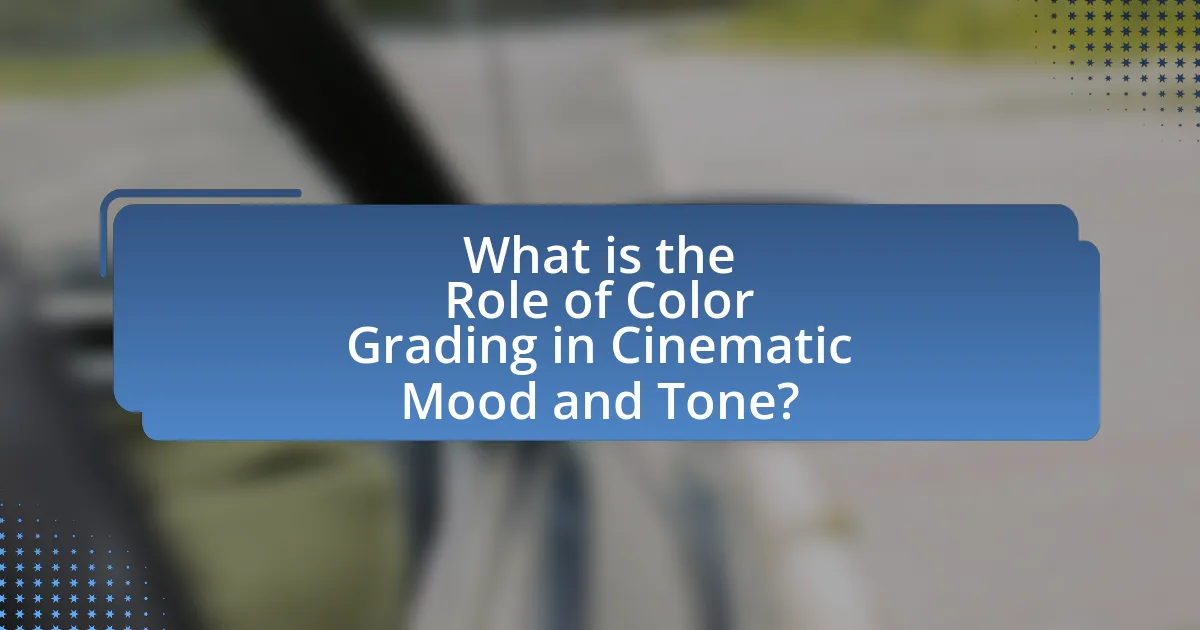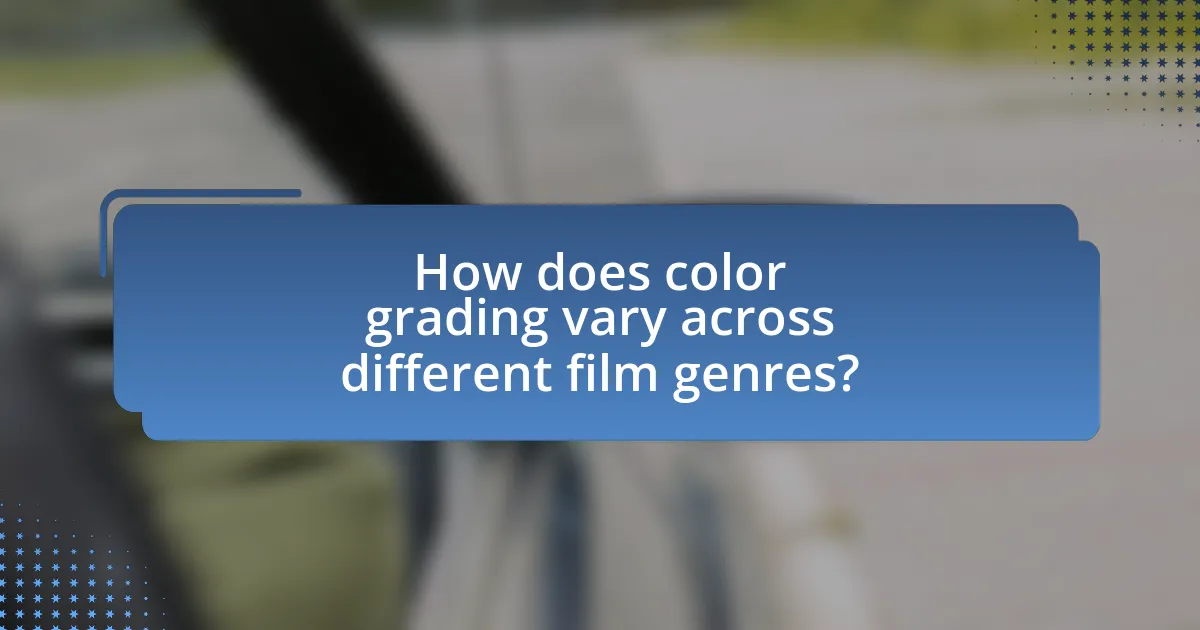Color grading is a critical aspect of filmmaking that significantly influences the mood and tone of a cinematic piece. By manipulating color palettes, filmmakers can evoke specific emotional responses, with warm colors creating feelings of comfort and nostalgia, while cooler tones often convey sadness or detachment. The article explores how color grading affects emotional impact, character development, and narrative themes, detailing key elements such as hue, saturation, brightness, and contrast. It also examines the techniques and tools used in color grading, the variations across different film genres, and best practices for achieving consistency and desired emotional effects throughout a film.

What is the Role of Color Grading in Cinematic Mood and Tone?
Color grading plays a crucial role in establishing the mood and tone of a cinematic piece by manipulating color palettes to evoke specific emotional responses. Through the use of warm colors, filmmakers can create feelings of comfort or nostalgia, while cooler tones often convey sadness or detachment. For instance, the film “The Matrix” employs a green tint to suggest a dystopian reality, influencing audience perception and emotional engagement. Studies have shown that color can significantly affect viewer psychology, with certain hues triggering distinct emotional reactions, thereby reinforcing the narrative’s themes and character arcs.
How does color grading influence the emotional impact of a film?
Color grading significantly influences the emotional impact of a film by altering the visual tone and atmosphere, which directly affects audience perception and feelings. For instance, warm tones like reds and yellows can evoke feelings of comfort or passion, while cooler tones such as blues and greens can create a sense of calm or sadness. Research indicates that color can trigger emotional responses; a study published in the journal “Color Research and Application” found that specific colors can elicit distinct emotional reactions, supporting the idea that filmmakers use color grading strategically to enhance narrative themes and character development.
What are the key elements of color grading that affect mood?
The key elements of color grading that affect mood include hue, saturation, brightness, and contrast. Hue determines the color itself, influencing emotional responses; for example, warm hues like red and orange evoke feelings of warmth and excitement, while cool hues like blue and green can create calmness or sadness. Saturation affects the intensity of the color; highly saturated colors can convey vibrancy and energy, while desaturated colors often evoke a more subdued or melancholic mood. Brightness influences the overall lightness or darkness of the image, where brighter scenes can feel uplifting and cheerful, while darker scenes may create tension or foreboding. Lastly, contrast, which refers to the difference between light and dark areas, can enhance drama and focus attention, thereby shaping the viewer’s emotional experience. These elements work together to establish the desired mood and tone in cinematic storytelling.
How do different color palettes evoke specific emotions?
Different color palettes evoke specific emotions by leveraging psychological associations tied to colors. For instance, warm colors like red and orange often elicit feelings of warmth, excitement, or aggression, while cool colors such as blue and green tend to promote calmness, tranquility, or sadness. Research by the Institute for Color Research indicates that people make a judgment about a person, environment, or product within 90 seconds, and 62-90% of that assessment is based on color alone. This demonstrates the significant impact color palettes have on emotional perception in visual media, including film and design.
Why is color grading essential in storytelling?
Color grading is essential in storytelling because it enhances the emotional impact and visual coherence of a narrative. By manipulating colors, filmmakers can evoke specific feelings, set the mood, and guide the audience’s perception of characters and events. For instance, warmer tones can create a sense of comfort or nostalgia, while cooler tones may evoke feelings of sadness or tension. Studies have shown that color can significantly influence audience emotions; for example, research published in the Journal of Experimental Psychology indicates that color affects mood and memory recall, reinforcing the idea that color grading is a powerful tool in storytelling.
How does color grading enhance narrative themes?
Color grading enhances narrative themes by visually reinforcing the emotional tone and atmosphere of a film. For instance, warm color palettes often evoke feelings of comfort and nostalgia, while cooler tones can create a sense of detachment or tension. This technique is evident in films like “The Godfather,” where the use of sepia tones emphasizes themes of family and legacy, or in “Mad Max: Fury Road,” where vibrant colors highlight chaos and urgency. By manipulating color, filmmakers can guide audience emotions and deepen their connection to the story, making the narrative more impactful and resonant.
What role does color play in character development?
Color plays a significant role in character development by influencing audience perception and emotional response. Specific colors can symbolize traits or emotions, such as red representing passion or anger, while blue may convey calmness or sadness. For instance, in film, a character dressed in dark colors may be perceived as villainous or troubled, while bright colors can indicate innocence or joy. This use of color not only enhances the visual storytelling but also deepens the audience’s understanding of a character’s journey and motivations, as seen in films like “The Sixth Sense,” where color coding is used to signify the emotional states of characters.

What techniques are used in color grading for cinematic effects?
Color grading for cinematic effects employs techniques such as color correction, color contrast adjustment, and the use of LUTs (Look-Up Tables). Color correction ensures that colors appear natural and consistent across scenes, while color contrast adjustment enhances the visual impact by manipulating the brightness and saturation levels. LUTs are pre-defined color profiles that can quickly apply a specific look or mood to footage, streamlining the grading process. These techniques are essential in shaping the overall aesthetic and emotional tone of a film, as evidenced by their widespread use in professional filmmaking to create distinct visual styles and enhance storytelling.
How do color grading tools and software contribute to the process?
Color grading tools and software enhance the visual storytelling of a film by adjusting the color balance, contrast, and saturation to evoke specific emotions and set the tone. These tools allow filmmakers to manipulate colors in a way that aligns with the narrative, creating a cohesive aesthetic that supports the story’s mood. For instance, software like DaVinci Resolve and Adobe Premiere Pro provides advanced features such as color wheels, curves, and LUTs (Look-Up Tables), enabling precise control over the visual output. Studies have shown that color can significantly influence audience perception; for example, warm tones often evoke feelings of comfort and happiness, while cooler tones can create a sense of sadness or tension. Thus, color grading tools are essential in shaping the audience’s emotional response and enhancing the overall cinematic experience.
What are the most popular software options for color grading?
The most popular software options for color grading include DaVinci Resolve, Adobe Premiere Pro, and Final Cut Pro. DaVinci Resolve is widely recognized for its advanced color correction tools and is used in professional film production. Adobe Premiere Pro offers integrated color grading features that are user-friendly and suitable for various projects. Final Cut Pro is favored by many Mac users for its intuitive interface and powerful color grading capabilities. These software options are frequently utilized in the film and video industry, demonstrating their effectiveness in enhancing visual storytelling through color grading.
How do professionals utilize these tools to achieve desired effects?
Professionals utilize color grading tools to manipulate the visual tone and mood of a film, enhancing storytelling and emotional impact. By adjusting parameters such as hue, saturation, and contrast, filmmakers can create specific atmospheres; for instance, cooler tones may evoke feelings of sadness or tension, while warmer tones can suggest comfort or nostalgia. Research indicates that color grading significantly influences audience perception, with studies showing that color can affect emotional responses and engagement levels in viewers. This strategic use of color grading is essential in aligning the visual narrative with the intended emotional experience, thereby achieving the desired effects in cinematic storytelling.
What are the common color grading techniques employed in films?
Common color grading techniques employed in films include color correction, color enhancement, and stylized grading. Color correction adjusts the overall color balance and exposure to achieve a natural look, ensuring consistency across shots. Color enhancement focuses on intensifying specific colors to evoke emotions or highlight elements within a scene. Stylized grading applies unique color palettes to create a specific mood or aesthetic, often seen in genres like horror or fantasy. These techniques are essential for shaping the visual narrative and emotional impact of a film.
How does the use of LUTs (Look-Up Tables) affect the final output?
The use of LUTs (Look-Up Tables) significantly enhances the final output by providing a consistent color grading framework that can transform the visual aesthetics of footage. LUTs allow filmmakers to apply predefined color adjustments, ensuring uniformity across different scenes and shots, which is crucial for maintaining a cohesive mood and tone throughout a cinematic piece. For instance, a study by the American Society of Cinematographers highlights that LUTs can streamline the color grading process, reducing time spent on manual adjustments while achieving professional-grade results. This efficiency and consistency directly impact the viewer’s emotional response, reinforcing the intended narrative and artistic vision.
What is the significance of contrast and saturation adjustments?
Contrast and saturation adjustments are significant because they directly influence the visual impact and emotional tone of an image or scene. By altering contrast, filmmakers can enhance the difference between light and dark areas, which can create depth, focus attention, and evoke specific feelings; for instance, high contrast can generate tension or drama, while low contrast may convey softness or nostalgia. Saturation adjustments affect the intensity of colors, where increased saturation can make a scene feel vibrant and energetic, while decreased saturation can evoke a more subdued or melancholic mood. Research indicates that these adjustments can significantly affect audience perception and emotional response, as demonstrated in studies on color psychology, which show that color manipulation can alter mood and narrative interpretation.

How does color grading vary across different film genres?
Color grading varies significantly across different film genres to enhance mood and tone. For instance, horror films often utilize desaturated colors and high contrast to create a sense of unease, while romantic comedies typically feature warm, vibrant hues to evoke feelings of joy and love. Action films frequently employ a cooler color palette with high saturation to amplify intensity and excitement. These variations are supported by studies indicating that color influences emotional responses; for example, research published in the Journal of Experimental Psychology shows that warm colors can increase feelings of warmth and happiness, while cool colors can induce calmness or sadness. Thus, filmmakers strategically use color grading to align visual aesthetics with the emotional undertones of their narratives.
What are the color grading trends in horror films?
Color grading trends in horror films often emphasize desaturated colors, high contrast, and a palette dominated by dark tones to evoke feelings of dread and suspense. Recent films frequently utilize teal and orange color schemes, which create a stark visual dichotomy that enhances tension. Additionally, the use of shadows and muted colors contributes to an unsettling atmosphere, as seen in films like “Hereditary” and “The Witch,” where the color grading reinforces the psychological horror elements. These trends are supported by studies indicating that color choices significantly impact audience emotions and perceptions, making color grading a crucial tool in horror filmmaking.
How do color choices create tension and fear in horror cinema?
Color choices create tension and fear in horror cinema by utilizing specific hues and contrasts that evoke emotional responses. Dark colors, such as blacks and deep reds, often symbolize danger and violence, while desaturated or muted tones can create a sense of unease and isolation. For instance, the use of stark contrasts between light and shadow can heighten suspense, as seen in films like “The Shining,” where the interplay of color enhances the psychological tension. Research indicates that colors like blue and green can induce feelings of coldness and dread, while red can trigger aggression and alertness, effectively manipulating audience emotions to amplify fear.
What specific color schemes are commonly used in horror films?
Commonly used color schemes in horror films include desaturated colors, high contrast, and monochromatic palettes. Desaturated colors, often featuring muted tones of gray, green, or brown, create a sense of unease and bleakness, enhancing the film’s ominous atmosphere. High contrast schemes, characterized by stark differences between light and dark, heighten tension and evoke fear by emphasizing shadows and silhouettes. Monochromatic palettes, utilizing variations of a single color, can evoke specific emotions and contribute to a surreal or unsettling mood. These color choices are supported by studies in film theory, which indicate that color significantly influences audience perception and emotional response, making these schemes effective tools in horror storytelling.
How does color grading differ in romantic films?
Color grading in romantic films typically emphasizes warm tones and soft contrasts to evoke feelings of intimacy and nostalgia. This approach often utilizes a palette dominated by reds, pinks, and golds, which are associated with love and warmth, creating an inviting atmosphere. For instance, films like “La La Land” and “The Notebook” employ these color schemes to enhance emotional connections between characters, reinforcing the narrative’s romantic themes. Studies in film aesthetics indicate that color grading significantly influences audience perception, with warm hues being linked to positive emotional responses, thereby validating the effectiveness of this technique in romantic storytelling.
What colors are typically associated with romance and intimacy?
Red and pink are typically associated with romance and intimacy. Red symbolizes passion and desire, while pink represents tenderness and affection. These colors are frequently used in various contexts, such as Valentine’s Day decorations and romantic films, to evoke feelings of love and connection. Studies in color psychology support this association, indicating that red can increase heart rates and stimulate emotions related to love, while pink is often linked to calmness and nurturing feelings.
How does lighting interact with color grading in romantic scenes?
Lighting significantly influences color grading in romantic scenes by enhancing emotional resonance and visual aesthetics. The interplay between soft, warm lighting and color grading techniques, such as desaturation or the use of pastel tones, creates an intimate atmosphere that evokes feelings of love and tenderness. For instance, studies in cinematography demonstrate that warm color temperatures (around 3200K) paired with specific color grades can amplify the romantic mood, making scenes feel more inviting and emotionally charged. This synergy between lighting and color grading is crucial in shaping the viewer’s emotional experience, as evidenced by films that utilize these techniques to effectively convey romance.
What are the best practices for effective color grading?
Effective color grading involves several best practices that enhance the visual storytelling of a film. First, understanding the emotional impact of colors is crucial; for instance, warm tones can evoke feelings of comfort, while cool tones may create a sense of distance or tension. Second, maintaining consistency throughout the project is essential to ensure that the color palette aligns with the narrative and character arcs. Third, utilizing color wheels and scopes allows for precise adjustments, ensuring that highlights, midtones, and shadows are balanced correctly. Additionally, referencing established color grading techniques, such as the use of LUTs (Look-Up Tables), can streamline the process and achieve desired looks efficiently. Finally, conducting thorough reviews and seeking feedback from peers can provide valuable insights, leading to a more polished final product. These practices are supported by industry standards and the experiences of professional colorists, who emphasize the importance of both technical skill and artistic vision in effective color grading.
How can filmmakers ensure consistency in color grading throughout a film?
Filmmakers can ensure consistency in color grading throughout a film by utilizing a standardized color grading workflow and reference tools. Implementing a color grading software that supports color management, such as DaVinci Resolve or Adobe Premiere Pro, allows filmmakers to maintain consistent color profiles across all scenes. Additionally, using color reference charts during filming helps establish a baseline for color accuracy, ensuring that all shots align with the intended aesthetic. Studies have shown that maintaining a consistent color palette enhances viewer engagement and emotional response, reinforcing the film’s mood and tone.
What tips can help achieve the desired mood through color grading?
To achieve the desired mood through color grading, utilize color theory principles by selecting hues that evoke specific emotions. For instance, warm colors like reds and oranges can create feelings of warmth and excitement, while cool colors such as blues and greens often convey calmness or sadness. Additionally, adjusting contrast and saturation levels can enhance the emotional impact; high contrast can create tension, while lower contrast can produce a softer, more nostalgic feel. Research indicates that color grading significantly influences audience perception, as demonstrated in studies showing that films with warmer tones are often perceived as more inviting (Kätsyri et al., 2015, “The Role of Color in Film: A Study of Color Grading and Audience Perception”).


